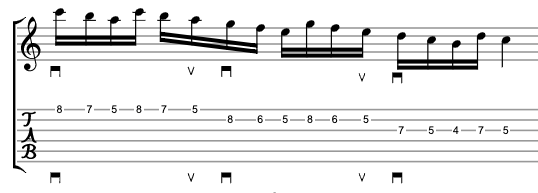Hi all,
Today I altered my thinking around a simple 6-note-per-string alt-picked ascending lick, and made some huge progress, finally playing the lick quite cleanly at 190 bpm with a great deal less effort and no apparent string noise. Here’s the lick:
I was doing even-notes-per-string and downward slant, so that the pick would escape the strings on the upstroke, and be free for the move to the next higher string.
I could play the individual strings cleanly (4-5-7-4-5-7 etc) at high speed, but still found that pick “bumped” the lower string when moving to the higher. I also found that the motions were rather tricky – the upstroke on the G string 7th fret followed by the downstroke on the B string – because in my mind, I was still thinking of my hand only shifting after playing the upstroke, or as part of it. The hand had to basically reposition itself within a 16th note. I think that my conscious idea of the motion made it trickier.
My discovery/thought was that I would instead start shifting my hand as part of the prior downstroke, and play the upstroke while my hand was repositioning itself. This way the hand would have a full eight note (down-up) to reposition itself, so that would be more relaxed. I shifted the focus of my thoughts to the downstrokes.
I practiced this downstroke-and-reposition slowly for a while to get the feel. I actually used the concept of “rest strokes” for the downstroke-with-shift while practicing, hoping that would give a clearer command to reposition the hand during the picking. I did this for a few short sessions over two days, and then bumped up the speed. It all seems to work very well, and there’s no tightening up.
It feels interesting – rather than concentration on the upstroke, and the “pick entering” on the next higher string, it feels much more like I am cleanly “exiting” the lower string, and the next string pretty much takes care of itself. There was a definite rhythmic feeling to the hand motion and reposition, and since the reposition uses an eighth note, it’s more relaxed. Also, the motion happens in the same direction as the pick motion, which also feels more natural.
Interestingly, the motion for descending licks is a bit easier for me:

The upstroke is already moving the hand in the correct direction (towards the next lower string), so it’s more of a quick “throwing” motion of the hand to the next lower string. There are some different hand sync issues when descending, which I covered in a different thread, but the picking motion and string change is, for me, a bit easier. Perhaps because I didn’t have a clear idea of what I was doing with it, so I didn’t overthink it!
Thought some might find it interesting. Cheers! jz






